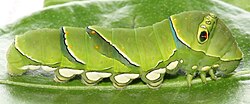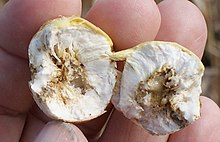For other uses, see Larva (disambiguation).
| This article does not cite any references or sources. (December 2009) |
Larva of Papilio xuthus, butterfly
A larva (plural larvae /ˈlɑrviː/) is a distinct juvenile form many animals undergo before metamorphosis into adults. Animals with indirect development such as insects, amphibians, or cnidarians typically have a larval phase of their life cycle.
The larva's appearance is generally very different from the adult form (e.g. caterpillars and butterflies). A larva often has unique structures and organs that do not occur in the adult form, and may have a considerably different diet.
Larvae are frequently adapted to environments separate from adults.[citation needed] For example, some larvae such as tadpoles live exclusively in aquatic environments, but can live outside water as adult frogs. By living in a distinct environment, larvae may be given shelter from predators and reduce competition for resources with the adult population.
Animals in the larval stage will consume food to fuel their transition into the adult form.[citation needed] Some species such as barnacles are immobile as adults, and use their mobile larval form to distribute themselves.
The larvae of some species (for example, some newts) can become pubescent and not further develop into the adult form. This is a type of neoteny.
Eurosta solidaginis Goldenrod Gall Fly larva
It is a misunderstanding that the larval form always reflects the group's evolutionary history. This could be the case, but often the larval stage has evolved secondarily, as in insects. In these cases the larval form may differ more than the adult form from the group's common origin.[citation needed]
Selected types of larvae
See also
- Crustacean larvae
- Ichthyoplankton
- Spawn (biology)
- Ecdysis
- Instar, intermediate between each ecdysis
- Other non-larval juveniles (imamture forms):
- Paralarva, young cephalopods
- Nymphs and naiads, immature forms in hemimetabolous insects
- Subimago, a juvenile that resembles the adult in Ephemeroptera
- Pupa and chrysalis, intermediate between larva and imago
- Imago, final stage
- Marine larval ecology
External links
 Media related to Larva at Wikimedia Commons
Media related to Larva at Wikimedia Commons The dictionary definition of larva at Wiktionary
The dictionary definition of larva at Wiktionary- Arenas-Mena, C. (2010) Indirect development, transdifferentiation and the macroregulatory evolution of metazoans. Philosophical Transactions of the Royal Society B: Biological Sciences. Feb 27, 2010 Vol.365 no.1540 653-669
Bibliography
- Brusca, R. C., & Brusca, G. J. (2003). Invertebrates (2nd ed.). Sunderland, Mass. : Sinauer Associates.
| This developmental biology article is a stub. You can help Wikipedia by expanding it. |
- Articles lacking sources from December 2009
- All articles lacking sources
- All articles with unsourced statements
- Articles with unsourced statements from September 2012
- Articles with unsourced statements from June 2013





0 comments:
Post a Comment